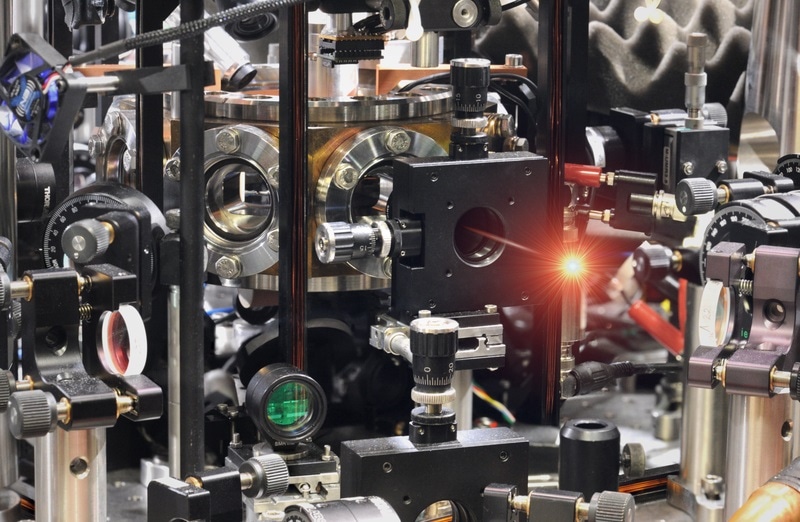Apr 25 2019
The alcohol content in spirits can be increased relative to the water content through distillation. A research team at the Max Planck Institute of Quantum Optics in Garching has created a similar technique that works on light quanta, or photons.
 Not quite like distilling schnapps: the Garching “photon still.” (Image credit: Severin Daiß)
Not quite like distilling schnapps: the Garching “photon still.” (Image credit: Severin Daiß)
The technique involves extracting individual photons from a light source, minimizing the undesirable vacuum component, and heralding the event. Single photons such as these are key quantum bits for the quantum information technology evolving at present. It is even possible to integrate this “photon distillation” to increase the purity of single-photon light. The study was recently published in Physical Review Letters.
It, in fact, reminds about the concept behind alcohol distillation, although the device housed in a lab at the Max Planck Institute of Quantum Optics looks totally different from the one used for distilling schnapps. Quite similar to the way distillation increases the content of alcohol in a beverage relative to its water content, the Garching experiment increases the individual photons relative to the vacuum.
Although this impulse might seem weird to common people, it directly leads to the unique realm of quantum physics. Extremely weak sources of light with the ability to deliver precisely one photon have a vital role to play in quantum information technology. A photon is a quantum bit that can carry the elementary quantum information needed for quantum encryption, quantum networks, and quantum computers—quite similar to how existing digital technology processes individual bits as carriers of information.
It is highly difficult to develop single-photon sources, and this has been studies across the globe for several years. This might sound shocking since only a single touch of a light switch is required to light up a room. But the light emitted from a lamp corresponds to a current of multitude photons. Upon making a light source so dim that only individual photons leave it, researchers encounter the roll-of-the-dice character of the quantum realm: at times, there is no photon and then there are two or three photons, and so on. It is somewhat equivalent to the drops from a still—it is not possible to predict when the drops will come or the size of the drops.
Rather than creating another single-photon light source, physicists from Gerhard Rempes’ division at the Max Planck Institute of Quantum Optics came up with a different concept: Their experiment has the potential to extract individual photons from the light of any light source that is very weak—similar to a still—and reliably record this event. To state precisely, the fraction of pure vacuum is reduced compared to the event of acquiring a photon. This is described by Severin Daiß, lead author of the study, who is a doctoral student at the institute. One of the unique qualities of the quantum realm is that a quantum state is represented by the vacuum itself. In order to prepare a photon with high cleanliness, it is necessary to avoid admixing of vacuum.
In the new study by the Rempes’ researchers, two challenges surfaced together. The first one is to acquire precisely one photon; the second one is the reliable detection of the photon. Both tasks are solved in a single step by a single rubidium atom. The atom is caught between two nearly perfect mirrors that face each other, in a type of mirror cabinet. The distance between the mirrors in this “resonator” is exactly proportionate to a multiple of half a wavelength of light in which the atom could absorb its own photon or radiate. In such a system, the atom will have the potential to flip between two states similar to a pointer; this has a key role to play here.
We can use this system of the atom in the resonator as a still for the photon.
Severin Daiß, Study Lead Author and Doctoral Student, Max Planck Institute of Quantum Optics
The Garching team directed very weak laser light—from which they intended to acquire a single photon—onto the cavity. There it performs something that holds good only in the quantum realm: It “entangles” with the atom-resonator setup to form an integrated quantum state. This entangled state converts the system into a still: By measuring the atom, physicists can extract an odd or an even number of photons from the incident light.
But this does not work similar a switch; the roll-of-the-dice property of the quantum realm blocks a photon from escaping at the push of a button. “What is decisive here is that we can now use the atom as a pointer to report a successful single-photon distillation”, explained Daiß. The physicists allowed the arrangement to “roll” photons but made the dice count to be displayed reliably.
When combined with ultra-weak light, the “odd photon number” mode can create events with one photon since more photons are not always available. The distillation was successful with a “purity” of 66%, implying that the vacuum content was decreased by one-third. This is a good outcome for a first attempt, in comparison with single-photon light sources.
It is possible to increase this purity considerably using better optical cavities. The purity of the photon that passes through can be further increased by connecting the photon distilling elements in series. It is also possible to enhance the quality of light from other single photon sources. It is similar to like making 60%, or higher, vodka from 40% vodka.